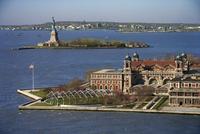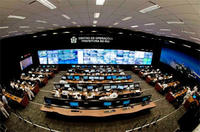-
Urban man-made drainage may increase risk of flooding
Installing drainage systems in developing towns and cities can cause water to reach rivers more quickly, potentially raising the risk of flooding, say scientists. They suggest that, in some cases, storm drains may do more to increase the risk of flooding than changes in the land surface.
-
-
Towns in northeast U.S. develop adaptation strategies for climate change
In many northeastern towns along the coast of the United States, local officials are attempting to identify and predict the effects of climate change which will occur over the next few decades. “You’re going to feel impacts. It’s a global issue with local effects…We don’t know exactly what’s coming, so let’s plan to be adaptable,” says a leader of a regional climate adaptation project.
-
-
Could devastating floods help Bosnians heal their war wounds?
The violent breakup of Yugoslavia in the 1990s and the subsequent war in Bosnia between 1992 and 1995 took the lives of more than 100,000 Bosnians and left two million homeless. Two decades later those survivors have been forced once again to abandon their homes — this time by floodwaters rather than bullets. The heaviest rainfalls ever recorded in the Balkans have led to catastrophic flooding in Bosnia and Herzegovina. Swelled by weeks of rain, the devastating floodwaters swamped more than 60 percent of the country last month, destroying more than 100,000 homes and displacing around 950,000 citizens. The floods also damaged vital infrastructure, destroyed industrial assets, and killed livestock. It is difficult to find a ray of light in this grim story of disaster, except this: Over the past weeks, media outlets have been flooded with stories and images of bravery, camaraderie, and community spirit where ethnicity suddenly became irrelevant. It remains to be seen how this feeling of camaraderie and community can be harvested to mobilize the people of Bosnia ahead of the general elections in October. Such a movement would have the potential to force corrupted political elites into the corner by draining them of their political capital.
-
-
New app helps kids in tornado-prone areas understand disasters
Kids growing up in tornado alley are used to bright, splotchy radar patterns moving across a television screen, and most know the difference between a tornado watch and warning. Do they understand, however, how to read and predict the weather based on radar images and forecasts? Researchers hope to remove the mystery around weather forecasting by speaking to kids in a language they could better understand — gaming.
-
-
Connecticut preparing for sea level rise, adapting to climate change

Earlier this year the University of Connecticut announced the creation of the Institute for Community Resiliency and Climate Adaptation. the Institute is designed to increase the resilience and sustainability of vulnerable communities and individuals along Connecticut’s coast and inland waterways as they are affected by the growing impact of climate change on the environment.
-
-
Nationwide effort launched to weather-harden Canadian cities
The frequency and magnitude of extreme weather events in Canada — from the floods in Southern Alberta and Toronto to the December ice storm in Central and Eastern Canada — are increasing, causing billions of dollars in damage to infrastructure, businesses and homeowners. Intact Financial Corporation and the University of Waterloo announced a national initiative involving the implementation of twenty climate change adaptation projects designed to reduce the physical, financial, and social impacts of extreme weather events in Canada.
-
-
Santa Monica to require retrofit of earthquake-vulnerable buildings
Last week, the Santa Monica City Councilauthorized city officials to hire engineering consultants to help identify buildings built before 1996 which could potentially be at risk in a major earthquake.. Owners of vulnerable buildings would be notified and provided recommendations on how to best retrofit their buildings to make them more resilient. Santa Monica will become the first city in California to require retrofitting for concrete, steel, and wood-frame. San Francisco last year required similar retrofitting, but only for wood apartment buildings.
-
-
Hurricanes with female names deadlier than male-named storms
In the coming Atlantic hurricane season, watch out for hurricanes with benign-sounding names like Dolly, Fay, or Hanna. According to a new study, hurricanes with feminine names are likely to cause significantly more deaths than hurricanes with masculine names, apparently because storms with feminine names are perceived as less threatening.
-
-
U.K. to face heavier, more frequent summer downpours, more destructive flash floods
Global warming could cause extreme summer downpours to become several times more frequent in the United Kingdom by 2100, a new study suggests. Its authors say this will likely lead to an increased risk of flash flooding, similar to the Boscastle floods of 2004 and the “Toon Flood” in Newcastle in 2012.
-
-
The five biggest threats to human existence

In the daily hubbub of current “crises” facing humanity, we forget about the many generations we hope are yet to come. Not those who will live 200 years from now, but 1,000 or 10,000 years from now. The word “hope” is appropriate because we face risks, called existential risks, which threaten to wipe out humanity. These risks are not just for big disasters, but for the disasters that could end history. These risks remain understudied. There is a sense of powerlessness and fatalism about them. People have been talking apocalypses for millennia, but few have tried to prevent them. Humans are also bad at doing anything about problems that have not occurred yet because of the tendency to overestimate the probability of events we know examples of, and underestimate events we cannot readily recall. There are some risks we cannot do anything at all about, such as gamma ray bursts that result from the explosions of galaxies. But if we learn we can do something, the priorities change.
-
-
The Pentagon integrates climate change into military planning
With the release of the National Climate Assessment last month, a clearer picture has emerged of the official policy-related interpretation of climate change data. The debate may still go on amongst civilian branches of government, and between the administration and its critics, the Pentagon, for some time now, has already been integrating climate change-related policies into its daily operations across all branches of the military.
-
-
Sea level rise, not Hurricane Sandy impacts, main cause of subsequent East Coast storm flooding
Flooding in coastal areas bordering Great South Bay, New York, and Barnegat Bay, New Jersey caused by winter storms that occurred following Hurricane Sandy was not influenced by changes Sandy made to barrier islands or other bay features, according to a new U.S. Geological Survey study. “While the existing barrier island and inlet system shield the mainland to a great extent from the daily tides, most of the storm surge, and all long-term changes in water level, such as those resulting from sea level rise, reach the mainland,” say the study’s authors.
-
-
Extreme weather events threaten U.S. national landmarks

Rising seas, floods, and wildfires are threatening the U.S. most cherished historic sites — from Ellis Island to the Everglades, Cape Canaveral to California’s César Chávez National Monument. Scientists say that today these sites face an uncertain future in a world of rising sea levels, more frequent wildfires, increased flooding, and other damaging effects of climate change. At some sites — such as Liberty and Ellis Islands and Cape Hatteras — steps have already been taken to prepare for these growing climate risks. At many other sites, such efforts have not yet begun.
-
-
Extreme weather exposes the toxic legacy of an industrial past
The increase in the number and intensity of extreme weather events in the United States carries with it yet another, more insidious danger: it forces to the surface toxic lead from long-shuttered smelters. Lead smelters had mostly closed down in the United States by the 1980s, but they left behind millions of tons of toxic waste. One example: In 2011, Joplin, Missouri suffered a devastating tornado which killed 158 people and flattened much of the city. Decades of lead processing in the Joplin area had created about 150 million tons of toxic wastes, with about 9 million tons still remaining after a federal Superfund cleanup. The 2011 tornado forced some of the buried lead to the surface, forcing Joplin to spend $3.5 million so far on lead clean up. The city now requires builders to test for lead, and clean up any traces, before beginning construction.
-
-
Rio builds a high tech integrated urban command center

Rio de Janeiro is one of the most densely populated cities in South America. Much of the city is vulnerable to flooding, and about three-quarters of Rio’s districts have areas at risk of landslides. High temperatures can make living situations unbearable. In addition, a high crime rate and poor infrastructure make the city difficult to govern. In preparation for the 2014 World Cup and 2016 Summer Olympics, authorities are looking to improve response times to disasters and establish a more efficient system to deal with the city’s many challenges. One of the solutions is a high tech integrated urban command center — Centro de Operações Preifetura do Rio de Janeiro (COR) – which unites Rio’s thirty departments and some private suppliers in a single monitoring room where operators can track real-time conditions of the city and coordinate a response to emergencies and disruptions.
-
More headlines
The long view
The Surprising Reasons Floods and Other Disasters Are Deadlier at Night
It’s not just that it’s dark and people are asleep. Urban sprawl, confirmation bias, and other factors can play a role.
Why Flash Flood Warnings Will Continue to Go Unheeded
Experts say local education and community support are key to conveying risk.
